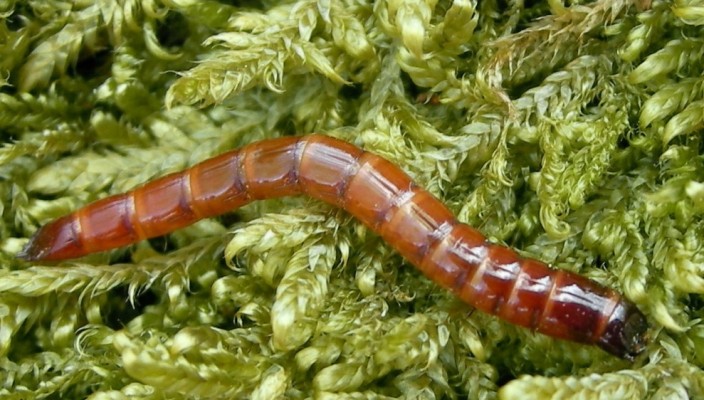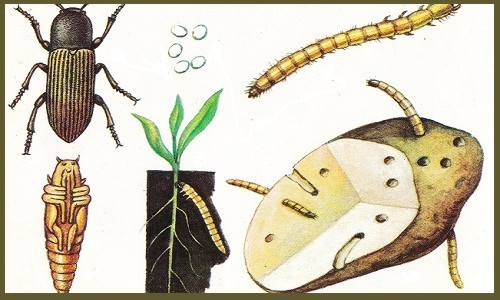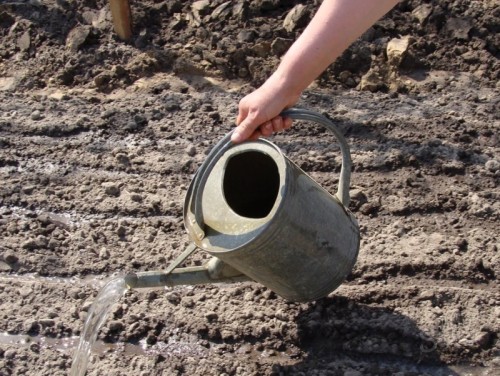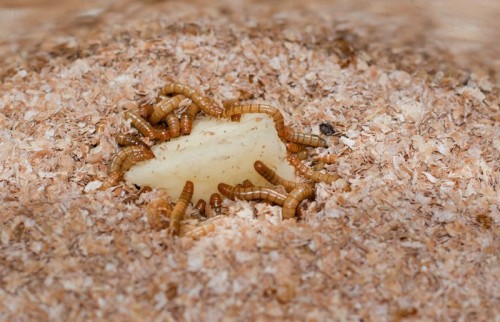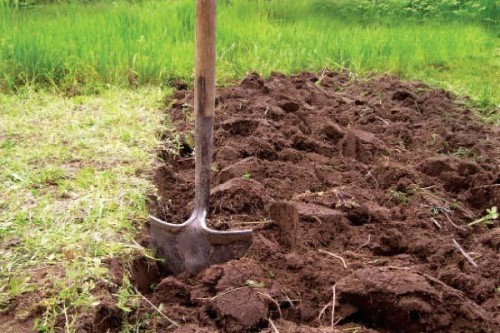Most rude lovers when growing vegetables on their summer cottage facing various problems. This is not only fertilizer and watering plants. The lion's time is driven to the fight against pests. And if the Colorado beetle is considered the main problem in the cultivation of potatoes, then you can face with an equally well-known, but very malicious enemy - a wiretop. It is very difficult to get rid of it, and crop losses are huge. What can be done to make rid of the beetle of the Wireman forever?
Content
Methods of getting rid of the garden pest are very much. You need to immediately tune in to the fact that at once it will not be possible to remove the wiretop. Perhaps some recommendations will help you, especially if the Earth has not yet had time to get completely infected. But this also does not mean that the pest is easy to remove. So immediately need to be tuned to a serious wrestling with a wireman. To understand how to protect the Earth and, accordingly, the future harvest, it is necessary to understand the life cycle of this beetle.
Read more about this pest
The wire is a small worm, its length is from 2 to 2.5 cm. The name of this pest is justified, if you touch it with your fingers, it will be very tough to the touch. It seems that you have touched the wire.
The coloring of the wireside is different, from dark brown, under the color of the wood bark, to the lighter, with a yellowish tint.
The wire has several stages of development. If you saw the plants in the form of a stick on the plant, then it is a larva zucchin. It can be light gray and dark, along the Taurus he has several dark stripes. The length of the body of the beetle - ranges from 10 to 15 mm. The pest has a fully justified name. It was nicknamed due to the fact that when the beetle flipped from the back on the stomach, then the characteristic click. The lifespan of the beetles of approximately 3-4 years. At a certain period of time, they lay the eggs of a round white shape. The size of the eggs is 1.5 mm, gradually they turn into larvae.
You can see the wire in the photo:
Intermediate stage of the development of pests - worms, they can be seen in the ground. These are white round oval larvae, which are gradually evolving in the wires. Stop the process of reproduction of the Wirehouse at this stage is much easier than in the future. A few years (3-4 years), the wire grows and becomes an adult beetle. During this period, it is already able to put eggs independently, that is, to start a re-cycle of development.
Strong harm to plants are applied larvae. They love to eat plant roots, as well as root roots. Adult beetles can get out to the surface when the soil starts to warm under the warm solar rays. Already in the end of the spring, you can detect the beetle of a shortcut or a wire carrier.
Permanent habitat of beetles - shaded places where much moisture and grass. Also love pests to settle in cereals.
Beetles love to eat ramp roots, but also do not mind to taste delicious root potatoes. Adult females lay eggs, they run in the soil at a depth of 1 to 3 cm. Eggs develop for 3 weeks, but can turn into larvae and much faster, it all depends on air temperature and soil moisture. Interestingly, adults do not die in the cold season. As soon as the process of pest development ends (and this is approximately mid-summer), then the beetles are plugged into the soil to a depth of 10 to 15 cm. Approximately 2-3 weeks (it depends on the variety of beetles), they come out of cocoons and remain wintering in the soil Before the onset of heat.
If you do not take any measures to combat the wiretop in the garden, then soon there will be many larvae of different ages. Naturally, every year the amount of harvest will begin to shrink.
The flap itself is not so harmful for garden crops, like his larvae. They begin to unzip the seeds just planted into the soil, and if the plant managed to rise a little and strengthen, then they are accepted for underground pieces of stems. Also larvae to provide themselves with intake, can attack the roots of plants, hit tubers and root. Visual "work" of the wire can be seen after harvest. If you dug up potatoes and saw that 50% of the harvest is very damaged (holes and moves from the wireman), then this means that it is time to combat the wiretop in the garden.
Wireless Measures
It is necessary to destroy the pest. If you run your garden, then there is anything in this soil, where thousands of larvae lives, and there can be no speech. There are 2 outputs: this is the processing of soil by chemicals and with the help of agricultural engineering.
The first embodiment is much simpler, because to destroy the pest, it is necessary to enter special chemicals in the soil, which will destroy the larvae. However, despite the simplicity, this method among gardeners is practically not successful due to the fact that the cost of such drugs is too high, and on the other hand, the ecology is applied. Indeed, as a result of the soil treatment with pesticides, the load increases. So why overload the land with chemicals, even if the larvae will die together with useful microorganisms (for example, rainworms die after treatment).
The second option is less destructive for the soil - this is an introduction to the soil fertilizer with nitrogen and ammonium. Soil treatment with ammonia water is carried out, only it will not be possible to do this, since the liquid must be strongly shuffled so that ammonia does not disappear. In a small summer cottage, this technique is not suitable. In addition, experienced agronomists have repeatedly come across that as soon as chemicals fall into the soil, the wires are trying to leave these places. Due to the fact that the pests move in the ground very slowly, it can be hoped that some of the wires will still die.
Among the agrotechnical means of dealing with a wireman in small areas, you can try such a method as deep peopling of the soil. Be sure to comply with the condition: to drag the soil 2 times a year (in spring and autumn), stick to a certain depth - up to 25 cm, plus during work it is important to manually choose the beetles, dolls and larvae. After these recommendations are taken into account, it is necessary to enter the ground chalk, lime or egg shell powder. In addition, you can enrich the soil with mineral fertilizers.
Announced a wire combat, do not forget to constantly destroy weeds. Bottva is undesirable to leave on the plot, since the larvae of beetles remain on it.
How to get rid of the wire
Every gardener has its own wire control methods, some allow partially to get rid of these pests, and some will help reduce the amount of the wire approximately half.
We propose to consider several popular wire control methods:
- for 2-3 years, the number of saccini beetle features in the country area can be reduced from 50 to 90%. What needs to be done: it is enough to breathe deeply in the fall in the fall in the fall. This can be done in the middle or late October to have time for permanent frosts. As a result of this processing of the larva, the wire and beetles, which hid the plump in the soil, will not be on the surface and they will not have chances for survival. The wire will just perish from the cold;
- you can try another effective method for the fight against the ladder - it is to remove the roots of chicken millet and spicy manually. Just keep in mind that even small roots need to ruthlessly pull out;
- surface loosening of the soil in the late spring and early summer. As a result, the moisture in the soil will continue, but the weeds will be destroyed. Just with them under the warm rays of the Sun, the eggs of beetles will die;
- in addition to loosenings, last year's wet grass, hay or straw can be decomposed throughout the plot. If the grass is dry, then it must be moistened, but to cover the boards on top. In such a shelter, the wires will soon move, heat there and there is food. After a few days, the bunches can be carefully assembled and burn. Such manipulation is repeated several times. The method of time consuming, but as a result, you can get rid of the larvae and beetles of pests;
- before planting potatoes (approximately 2 weeks) on the site you need to sow grains of oats or barley, but only nests, every 60 cm. After shoots appear, the culture must be digging and choosing all the wires;
- for those gardeners who want to grow elite and rare potato varieties on their plot, you can do this: soak the tubers in the brave of Celebre. Pests such a delicacy will not like;
- if there are small areas affected by a wirefish in your garden, you can plant potatoes, and next door to sow bean, rape or buckwheat. In such a landing there is plenty of advantages, a new culture in the garden has not yet causes the addictions by the Wirehouse, because he has not yet adapted to this food. As a result, most pests may die. In addition, alternation in the landing will give the opportunity to enrich the soil with a biological pure fertilizer;
- if you perform the right crop rotation, you can refuse to use pesticides. Suppose you planted the disappearance of culture and legumes, just will allow you to get rid of the pests, but also from weeds.
How to get rid of a wireworker in potatoes
In order to declare the struggle with a wireborator, it is necessary to know his tactics of behavior:
- The pest loves so that there are many weeds on the site, in particular - diper.
- When plants are planted too thick.
- Sound and raw soil.
What the wire does not love:
- peas;
- legumes;
- beans;
- nut.
Based on this, it is possible to make this conclusion: if you regularly loose the soil (especially in the arses), plant plants at a distance along with the bean, then you can reduce the amount of the wire in the garden.
What else can be done to save potatoes from pests:
- if there is an increased acidity in your site, the wire will gradually go away;
- when the soil is peashed, you can make a salter (on 1m 2 - 30 g);
- pour into the well when planting potatoes in 500 ml of manganese solution (take 5 g of mangarteau to 10 liters);
- take advantage of the recommendation of the experienced gardens: Arrange the baits from potato pieces to which you need to tie a fishing line. Skip the treat to a depth of up to 5 cm. If the soil is dry, specifically water these places. A few days later, you can check the bait, if you saw that the larvae climbed into the potatoes, then they need to be removed and again bury pieces of potatoes;
- suppress Siderate Wires. For example, you can plant a mustard near Potato (you can not use Oats and Rye - the wire is very like these cultures).
Folk remedy for the wireman:
- The above is already described how to get rid of pests when growing potatoes. You need to clean a small potato and use it as bait. Important: When you get sucking individuals, they need to be destroyed correctly. For this latch, the kerosene is poured, and then burned or thrown into a container with boiling water.
- When you plant potatoes, put squeeze chopped eggshell into each well (wet sunflower oil). Wire supports your delicacy, he will be bad and he will die.
- For a half months before the potatoes need to be searched, plant corn (15 swollen grains in one nest). Total such sites can be distinguished by several. Also, only corn tastes, it needs to dig up with the ground, put on a solid surface (plywood or film), choose the larvae of the lads and burn.
- It is very effective in combating a wire and such a method: in the well when planting potatoes, you need to pour a little dry onion husk. Periodically throw the husk and between the rows.
- You can plant velets around the perimeter of the site where potatoes are planted.
- Try more such an option: fir or pine needles need to be shipped on the site - a ladder, and at the same time a bear, such a soil will not like it.
- You can get rid of almost completely from the wire with the help of microscopic predatory worm of nematodes. It is part of the healing soil called "Protection". When planting potatoes in each yam, you need to put on a pinch of soil. Nematodes will quickly destroy the wireman. By the way, such a soil is absolutely safe for cultures and does not harm the environment or human health.
As you can see, get rid of the wire is very difficult, but if you fight this pest together with your neighbors, then the result will be good. After all, the wire can migrate from one site to another, and all your efforts will be in vain.
How to get rid of the wire, you can see the video material:

